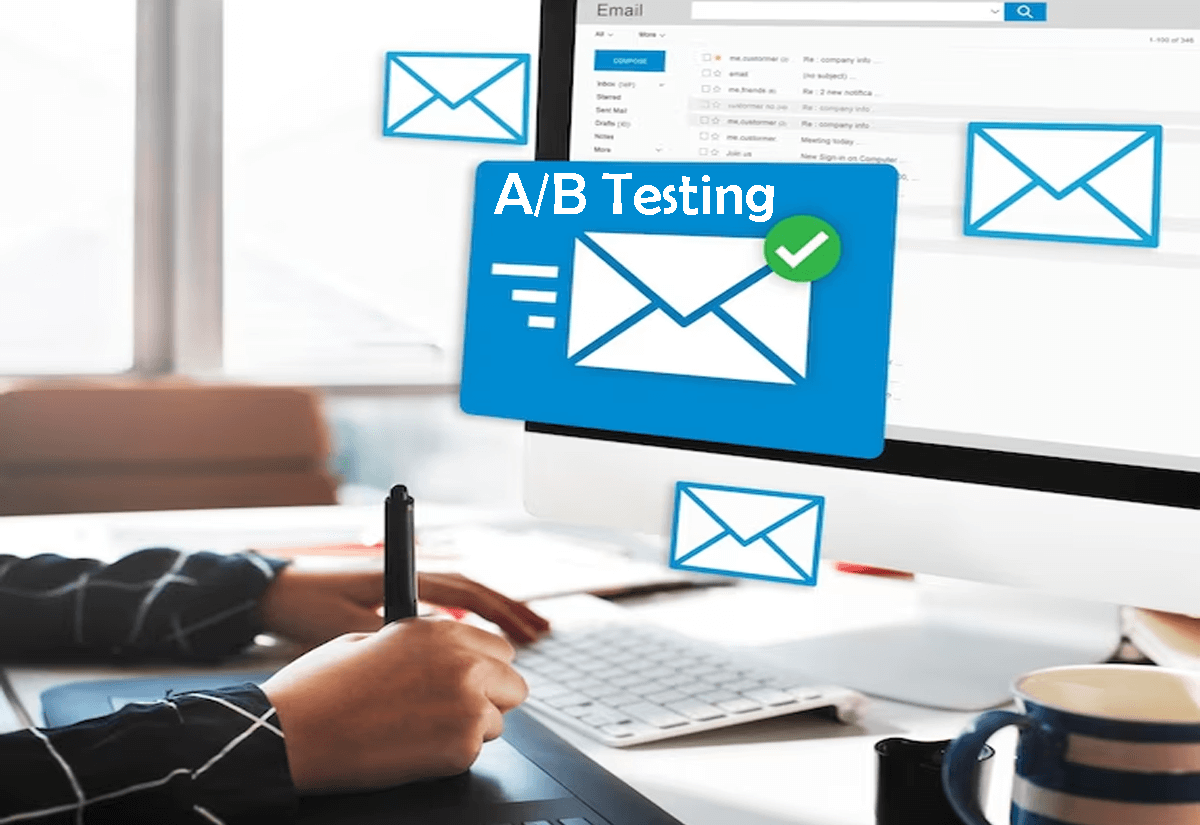What's Inside?
What is A/B Testing?
A/B testing is a technique used by companies to compare two different versions of something, like a webpage, email, or advertisement, to find out which one works better. It’s like a friendly competition between Version A and Version B to see which version gets more clicks, sales, or other desired outcomes. To do A/B testing, a company divides its audience into two groups randomly. One group sees Version A, while the other sees Version B. By analyzing the results and comparing how each group responds, the company can figure out which version is more effective. A/B testing helps companies make informed decisions based on real user feedback, allowing them to improve their products, websites, or marketing strategies to get better results. It’s an important tool that helps companies understand what works best for their audience and make smarter choices to achieve their goals.
Benefits of A/B Testing
A/B testing offers several benefits that can greatly impact a company’s success. Firstly, it helps businesses make informed decisions based on real data rather than assumptions or guesswork. By comparing different versions, companies can uncover valuable insights about what their customers prefer and respond to. Secondly, A/B testing allows for continuous improvement. By testing and implementing changes, companies can iterate and refine their strategies to achieve better results over time. Thirdly, A/B testing mitigates risks by identifying potential pitfalls before fully implementing them. It allows companies to make adjustments and avoid costly mistakes. Additionally, A/B testing promotes innovation and creativity by encouraging experimentation and exploring new ideas. It empowers companies to try different approaches and discover effective solutions. Ultimately, A/B testing leads to enhanced customer experiences, increased conversions, and improved overall performance, making it an indispensable tool for businesses seeking growth and success.
A/B Testing Process

The A/B testing process consists of several steps that help companies compare two different versions and determine the better-performing option. Here’s how it works:
- Identify the Goal: Companies start by defining a specific goal for the test, such as increasing clicks or improving conversions.
- Select the Element: The next step is to choose the element to test, such as a headline, image, or call-to-action button.
- Create Variations: Companies create two versions, A and B, with one differing element. Version A represents the original or current version, while Version B includes the modification being tested.
- Split the Audience: The audience is randomly divided into two groups: Group A and Group B. Group A sees Version A, and Group B sees Version B.
- Run the Test: Both versions are simultaneously shown to their respective groups. Companies track and measure user interactions, such as clicks, conversions, or time spent on a page.
- Analyze the Results: Companies analyze the data collected during the test period to compare the performance of Version A and Version B. They look for statistically significant differences to determine the winning version.
- Implement the Winner: The version that performs better in achieving the desired goal is chosen as the winner. Companies then implement this winning version as the default option.
- Iterate and Improve: A/B testing is an iterative process. Companies learn from the results, make further modifications, and conduct additional tests to continually optimize their marketing strategies and achieve better outcomes.
By following this A/B testing process, companies can make data-driven decisions, enhance user experiences, and continually improve their marketing efforts to achieve their goals effectively.
Planning an A/B Test
Planning an A/B test is a crucial step to ensure the test is well-executed and delivers meaningful insights. Here are some important considerations when planning an A/B test:
- Define the Objective: Start by clearly defining the goal of the test. What specific metric or outcome are you trying to improve? This could be increasing click-through rates, boosting conversions, or enhancing user engagement.
- Choose the Element: Identify the specific element you want to test. It could be a headline, call-to-action button, layout, color scheme, or any other element that might impact user behavior.
- Set the Variation: Determine the variations you want to test for the chosen element. This could involve creating two different versions, A and B, with one key difference between them.
- Determine the Sample Size: Consider the number of users or participants needed to generate statistically significant results. A larger sample size generally provides more reliable and conclusive findings.
- Randomization and Segmentation: Randomly assign users to either Group A (Version A) or Group B (Version B). This helps minimize bias and ensures fair testing. If relevant, consider segmenting users based on specific characteristics or demographics.
- Test Duration: Decide on the duration of the test to gather sufficient data for analysis. Factors like traffic volume and the expected rate of change can influence the test duration.
- Analyze Results: Determine the key performance metrics to track and analyze, such as click-through rates, conversions, or revenue. Use appropriate statistical methods to compare the results between versions and assess statistical significance.
- Implement and Iterate: Based on the test results, implement the winning version and monitor its impact on the desired metric. Continuously iterate and refine your strategies based on the insights gained from the A/B test.
By carefully planning an A/B test, businesses can ensure meaningful results and make data-driven decisions to optimize their marketing efforts. Effective planning sets the foundation for successful A/B testing and helps drive improvements in user experiences and overall performance.
Key Metrics for A/B Testing
When conducting an A/B test, it’s essential to define and focus on key metrics to evaluate the performance of different versions. Here are some important metrics to consider:
- Click-through rate (CTR): CTR measures the percentage of users who clicked on a specific element, such as a button or link. It helps assess the effectiveness of call-to-action elements and the overall engagement with the tested variations.
- Conversion rate: The conversion rate tracks the percentage of users who completed a desired action, such as making a purchase, filling out a form, or subscribing. It reflects the effectiveness of the tested versions in driving desired outcomes.
- Bounce rate: Bounce rate indicates the percentage of users who leave a webpage without interacting further. A lower bounce rate suggests better user engagement and interest in the tested variations.
- Time on page: Time on page measures the average duration users spend on a webpage. It helps gauge user engagement and whether the tested versions effectively capture and retain user attention.
- Revenue per user: Revenue per user assesses the average amount of revenue generated per user. It is particularly relevant for e-commerce businesses and indicates the monetary impact of the tested versions.
- Return on investment (ROI): ROI measures the financial return gained from the A/B test in relation to the cost of running the test. It helps evaluate the effectiveness and profitability of the tested variations.
- User satisfaction: User satisfaction can be measured through surveys, feedback, or ratings. It provides qualitative insights into how users perceive and interact with the tested versions.
These key metrics provide valuable insights into the performance and effectiveness of A/B test variations. By tracking and analyzing these metrics, businesses can make data-driven decisions and optimize their strategies to achieve their desired goals.
Best Practices for A/B Testing
Implementing best practices for A/B testing can greatly enhance the effectiveness and reliability of your tests. Here are some key practices to consider:
- Define clear goals: Clearly define the specific goals and metrics you want to improve through the A/B test. This helps keep the focus and ensures that the test aligns with your objectives.
- Test one element at a time: Test one element at a time to isolate the impact and accurately attribute any changes in performance to that specific element. Testing multiple elements simultaneously can make it difficult to determine which change led to the observed results.
- Randomize and segment users: Randomly assign users to different versions and consider segmenting users based on relevant characteristics. Randomization helps reduce bias, while segmentation allows you to analyze the impact of the test on specific user groups.
- Sufficient sample size: Ensure that your sample size is sufficient to generate statistically significant results. A larger sample size increases the reliability of the test and allows for more accurate conclusions.
- Monitor external factors: Be aware of external factors that could influence the results, such as seasonality, marketing campaigns, or user behavior changes. Monitor and account for these factors during the analysis to better understand the test outcomes.
- Continuously iterate and learn: A/B testing is an iterative process. Learn from each test and apply the insights gained to refine and optimize future experiments. Embrace a culture of continuous learning and improvement.
- Document and share findings: Document the results, insights, and learnings from your A/B tests. Share the findings with relevant stakeholders, ensuring clear and effective communication of the outcomes and implications.
- Consider long-term impact: Consider the long-term impact of the changes tested. Analyze how the variations may affect user behavior, engagement, or conversions beyond the initial test period.
By following these best practices, you can ensure rigorous and effective A/B testing. By establishing clear goals, testing one element at a time, randomizing users, monitoring external factors, and iterating based on learnings, you can make data-driven decisions, optimize your strategies, and continuously improve your performance.


